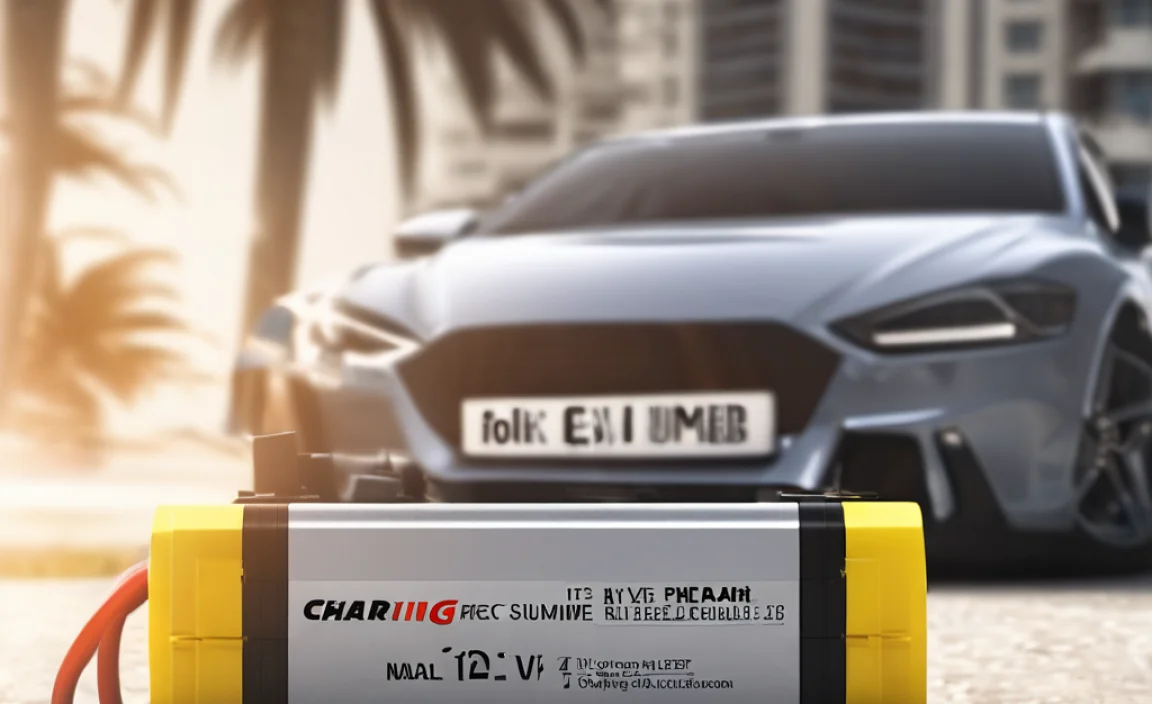Quick Summary: Rechargeable batteries are key to keeping your cordless phone running. Using the right ones, understanding how they work, and knowing how to care for them ensures your phone always has power. This guide makes it simple to manage your cordless phone’s rechargeable batteries so you’re never caught without a connection.
Rechargeable Batteries: Genius Essential Cordless Phone Power
Is your cordless phone always dying? It’s frustrating when you can’t answer a call or make an important one because the battery is dead. Many of us have been there, staring at a blinking low-battery icon. But don’t worry, powering your cordless phone is much simpler than you might think. Rechargeable batteries are the secret sauce, and understanding them makes all the difference.
This guide will walk you through everything you need to know about these handy power sources for your cordless phone. We’ll cover what they are, how to choose the right ones, and simple tips to keep them working their best. You’ll be a cordless phone battery pro in no time!
Understanding Cordless Phone Batteries
Cordless phones rely on special rechargeable batteries. Unlike the batteries in your TV remote, these pack a lot more power and are designed to be topped up many times. They fit right inside your cordless phone handset, giving it the juice it needs to connect to its base station.
Over time, these batteries wear out. They start to hold less charge, meaning you have to put the phone back on the charger more often. Replacing them is usually straightforward and will bring your phone back to life.
Types of Rechargeable Batteries for Cordless Phones
There are a few types of rechargeable batteries you might find in cordless phones. The most common are Nickel-Metal Hydride (NiMH) and, less commonly now, Nickel-Cadmium (NiCd). Newer phones might use Lithium-ion (Li-ion), similar to what’s in your smartphone, but this is less common for standard cordless phones.
Nickel-Metal Hydride (NiMH) Batteries
NiMH batteries are the most prevalent for modern cordless phones. They are a good upgrade from older NiCd batteries. They hold more power, last for more recharges, and are better for the environment because they don’t contain cadmium.
- Pros: High capacity, good lifespan, more eco-friendly than NiCd.
- Cons: Can lose charge over time if left unused (self-discharge), may need a few charge cycles to reach full capacity initially.
Nickel-Cadmium (NiCd) Batteries
You’ll find these in older cordless phones. While they were once the standard, they have some drawbacks. NiCd batteries suffer from the “memory effect.” This means if you recharge them before they are fully drained, they can “remember” the partial charge and won’t hold a full charge anymore. They also contain toxic cadmium, making them less environmentally friendly.
- Pros: Can deliver high current, robust in a wide temperature range.
- Cons: Memory effect, lower energy density than NiMH, contain toxic materials.
Lithium-ion (Li-ion) Batteries
While not as common in traditional cordless phones, Li-ion batteries are found in some advanced or newer models. They are known for being lightweight and holding a lot of charge for their size. They don’t suffer from the memory effect and have a low self-discharge rate.
- Pros: Lightweight, high energy density, no memory effect, low self-discharge.
- Cons: Can be more expensive, require specific charging circuitry, can degrade over time with heat or overcharging.
Why Do Cordless Phone Batteries Need Replacing?
Like all batteries, the rechargeable ones in your cordless phone have a limited lifespan. This lifespan is measured in charge cycles – how many times they can be fully charged and discharged before their performance drops significantly. Over time, the internal chemistry of the battery degrades, and it simply can’t hold as much energy as it used to.
Several factors can speed up this process:
- Age: Batteries naturally degrade over time, even if not used heavily.
- Charge Cycles: Each time you charge and discharge the battery, it counts towards its lifespan.
- Heat: Excessive heat, like leaving the phone in a hot car or near a heater, can damage batteries.
- Deep Discharges: Letting the battery drain completely very often can shorten its life.
- Improper Charging: Using the wrong charger or leaving the phone on the charger for excessively long periods might affect some battery types.
When to Replace Your Cordless Phone Batteries
It’s usually time to think about replacing your cordless phone batteries when you notice:
- The handset only lasts a short time off the charger.
- The phone takes an unusually long time to charge.
- The battery performance is inconsistent, sometimes working fine and other times dying quickly.
- The phone displays a constant “low battery” warning even after charging.
Don’t let a weak battery frustrate you. Replacing it is often a quick fix that gives your cordless phone a new lease on life!
How to Choose the Right Replacement Batteries
Picking the correct replacement battery is crucial. Using the wrong type or size can damage your phone or simply not work.
1. Check Your Phone’s Manual
The best place to start is always your cordless phone’s user manual. It will specify the exact battery type, size, voltage, and capacity (measured in mAh) recommended by the manufacturer.
2. Inspect the Old Battery
If you no longer have the manual, you can often find the information printed directly on the old battery. Look for:
- Battery Type: (e.g., NiMH, AAA, 1000mAh)
- Size: (e.g., AAA, AA, specific shapes for some models)
- Voltage: (e.g., 1.2V, 3.7V)
- Connector Type: Some batteries have specific wires and connectors.
3. Match Specifications
When buying new batteries, make sure the specifications match your old ones. Pay close attention to the battery type (NiMH is most common for cordless phones) and the capacity (mAh). A higher mAh rating means the battery can hold more charge and will last longer between charges.
4. Buy from Reputable Sources
Purchase batteries from established electronics stores or online retailers specializing in batteries. This helps ensure you’re getting quality products that are safe and perform as expected.
Example Battery Specifications:
| Specification | Typical Value for Cordless Phones | Importance |
|---|---|---|
| Battery Type | NiMH (Nickel-Metal Hydride) | Ensures compatibility with your phone’s charging system and performance characteristics. |
| Size | AAA or AA | Must physically fit inside the handset compartment. |
| Voltage | Typically 1.2V | Must match the original battery’s voltage to avoid damaging the phone’s electronics. |
| Capacity (mAh) | 600mAh – 1200mAh (or higher for some models) | Determines how long the phone will operate on a single charge; higher mAh means longer talk time. |
| Connector | Often a plug with two or three wires | Needs to be identical to the one on your old battery or compatible with your phone’s port. |
How to Replace the Battery in Your Cordless Phone Handset
Replacing the battery is usually a simple DIY task. Here’s a general guide:
Tools You Might Need:
- The new replacement battery pack
- A small Phillips head screwdriver (sometimes)
- A plastic spudger or thin credit card (optional, to gently pry open the casing)
Step-by-Step Guide:
- Unplug the Handset: If your phone has a charging cradle, make sure the handset is not currently charging. It’s also a good idea to unplug the base station from the wall power to be extra safe.
- Locate the Battery Compartment: This is usually on the back of the handset. There might be a small latch or clips that allow you to slide or lift off the battery cover.
- Remove the Old Battery Cover: If there’s a latch, slide it to open. If it’s clipped, gently press the clips. Some covers might require a small screwdriver to remove a screw.
- Remove the Old Battery: Most cordless phone batteries are plug-in types. They might have a small connector that you can gently pull straight out. Some might be held in place by a plastic clip or tape. Be careful not to force it. If it’s stuck, check for any hidden clips or screws.
- Connect the New Battery: Take your new battery and align the connector with the port inside the phone. Gently push it in until it’s firmly seated. Ensure the wires are not pinched.
- Place the Battery: Position the new battery in the compartment. It should fit snugly.
- Replace the Battery Cover: Slide or clip the cover back into place. Make sure it snaps securely. If you removed a screw, reinsert and tighten it.
- Charge the New Battery: Place the handset back on its charging cradle. For new NiMH batteries, it’s often recommended to charge them fully for 12-24 hours before the first use. Follow any specific instructions that came with your new batteries or phone.
Safety Tip: Never try to open a battery that looks swollen, damaged, or is leaking. These batteries can be hazardous and should be disposed of properly.
Maximizing the Lifespan of Your Cordless Phone Batteries
Once you’ve replaced your batteries, you’ll want them to last as long as possible. Here are some simple tips:
- Charge Fully: When you get new batteries, charge them for the full recommended time (often 12-24 hours for NiMH) before using them.
- Avoid Deep Discharges (Mostly): For NiMH batteries, try to avoid letting them drain completely every single time. Leaving them on the charger overnight is usually fine for most modern cordless phones, as they have trickle charges or protection circuits.
- Keep Them Cool: Don’t leave your cordless phone handset in very hot places, like direct sunlight or inside a hot car. Extreme temperatures can significantly degrade battery life.
- Use the Correct Charger: Always use the charger that came with your cordless phone system or a compatible replacement. Using the wrong charger can overcharge or undercharge the batteries, reducing their lifespan.
- Clean the Contacts: Occasionally, the charging contacts on the handset and the cradle can get dusty or corroded. A gentle wipe with a clean, dry cloth (or one slightly dampened with rubbing alcohol) can ensure a good connection.
These simple habits can extend the life of your rechargeable batteries and save you money in the long run.
When Cordless Phone Batteries Aren’t the Issue
Sometimes, you might be experiencing power issues with your cordless phone, but it’s not necessarily the batteries. Here are a few other things to check:
- The Charging Base: Ensure the power adapter is securely plugged into both the base and the wall outlet. Try plugging the adapter into a different outlet to rule out an outlet issue.
- The Phone Line: While not directly related to battery power, a faulty phone line can sometimes cause strange operational issues.
- Interference: Other electronic devices can sometimes interfere with the signal between the handset and the base, leading to dropped calls or poor sound quality, which might be mistaken for a battery problem.
- Internal Phone Fault: In rare cases, there might be a problem with the phone’s internal circuitry.
Caring for Batteries in Other Devices
The principles of battery care for your cordless phone often apply to other devices too. For instance, your smartphone’s battery (usually Li-ion) also benefits from avoiding extreme heat and using the correct charger. Even car batteries, while physically different, need proper maintenance to ensure reliable power.
For car batteries, regular checks of the terminals for corrosion and ensuring the battery is securely mounted are key. Cold weather is a major factor for car batteries, so keeping them in good condition can prevent frustrating breakdowns. Reputable automotive resources, like those from the U.S. Department of Energy’s Vehicle Technologies Office, offer great advice on battery maintenance and care.
Power banks, your portable phone chargers, also use Li-ion technology. To keep them working well, avoid letting them completely discharge every time, and store them in a moderate temperature. Just like your cordless phone batteries, they have a finite lifespan.
Frequently Asked Questions (FAQ)
Q1: How long should my cordless phone batteries last?
A1: This depends on the battery type and usage. NiMH batteries typically last 2-5 years or about 1,000-3,000 charge cycles before their capacity significantly decreases.
Q2: Can I use rechargeable AAA batteries in my cordless phone if the old ones were disposable AAA?
A2: Only if your phone is designed for rechargeable batteries and the rechargeable AAA batteries have the correct voltage (usually 1.2V) and capacity (mAh) and a compatible connector. Many phones are designed specifically for rechargeable battery packs, not standard disposable AAA batteries.
Q3: My new batteries won’t hold a charge. What’s wrong?
A3: Ensure you’ve charged them for the recommended time, especially for the initial charge. Also, double-check that the connector is seated properly and that you have the correct battery type and voltage for your phone. Defective batteries are also possible, so check with the retailer if issues persist.
Q4: Is it bad to leave my cordless phone on the charger all the time?
A4: For most modern cordless phones with NiMH batteries, it’s generally okay. They usually have systems to prevent overcharging. However, for older phones or certain battery types, it might be best to let the battery drain slightly before recharging. Check your phone’s manual for specific advice.
Q5: What does mAh mean on a battery?
A5: mAh stands for milliampere-hour. It’s a measure of the battery’s capacity – essentially, how much electrical charge it can hold. A higher mAh number means the battery can supply power for a longer time before needing to be recharged.
Q6: How do I dispose of old cordless phone batteries?
A6: It’s important to dispose of rechargeable batteries responsibly. Do not throw them in regular household trash. Many electronics stores and local recycling centers have battery recycling drop-off points. Look for facilities that accept NiMH or NiCd batteries.
For a guide on battery recycling, you can consult resources like the Environmental Protection Agency (EPA)’s information on household hazardous waste.
Conclusion
Keeping your cordless phone powered up is a simple matter of understanding its rechargeable batteries. By choosing the right replacements, following easy installation steps, and adopting good battery care habits, you can ensure your phone is always ready when you need it. Don’t let a dead battery interrupt your important calls or leave you feeling disconnected. With this guide, you have the knowledge to manage your cordless phone’s power source effectively, making it a reliable tool in your home or office.





